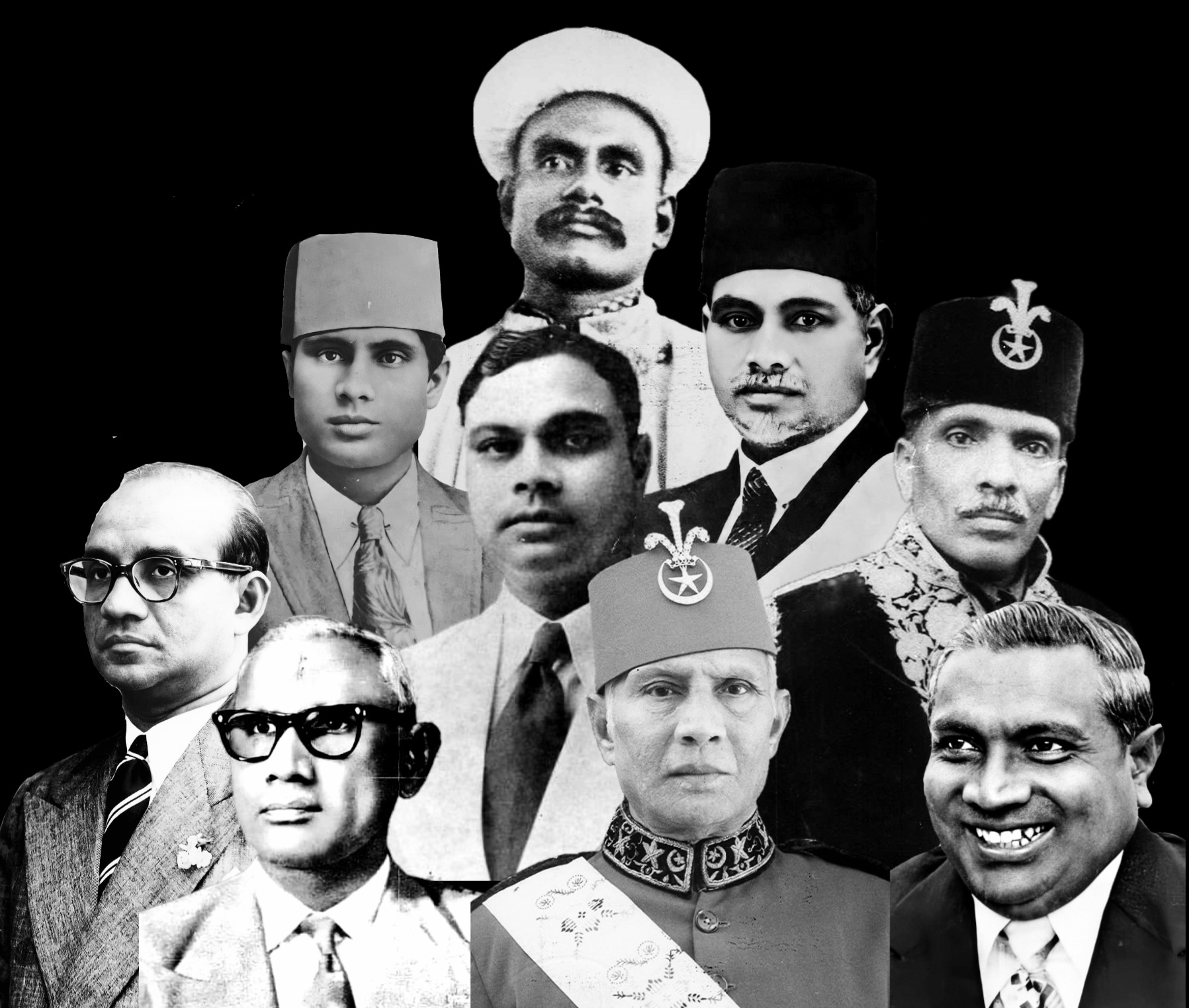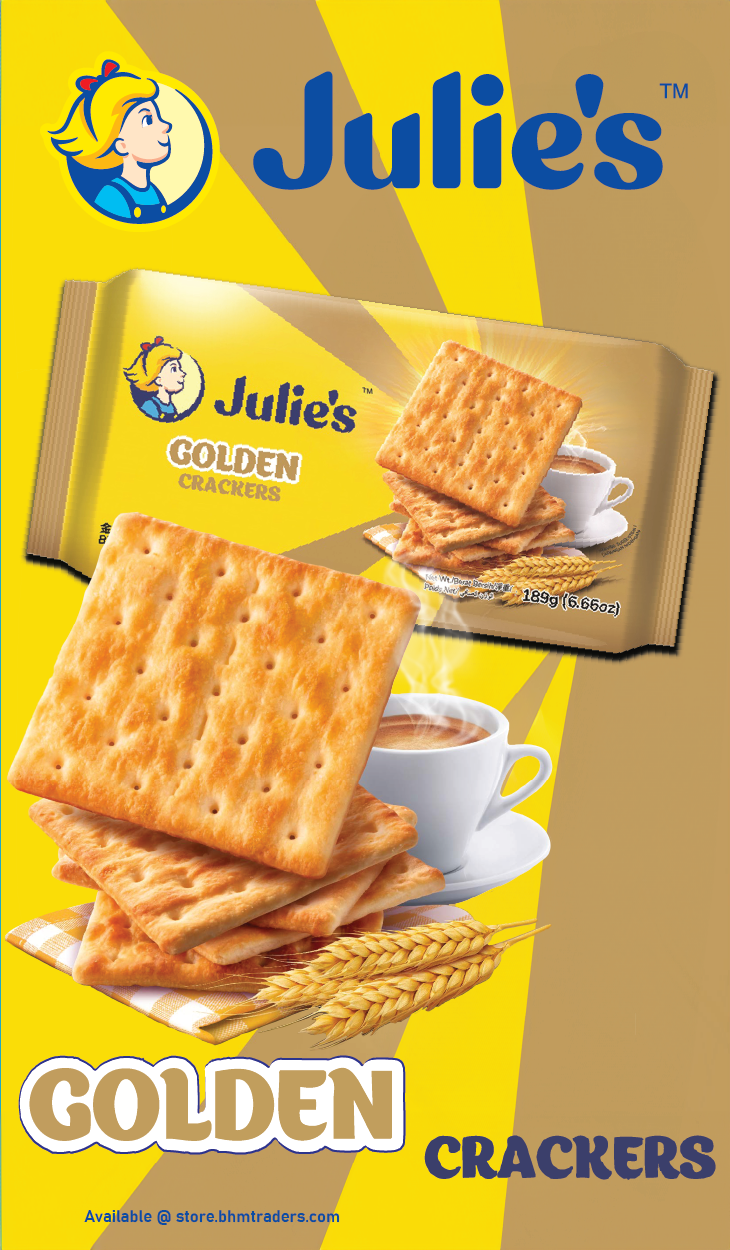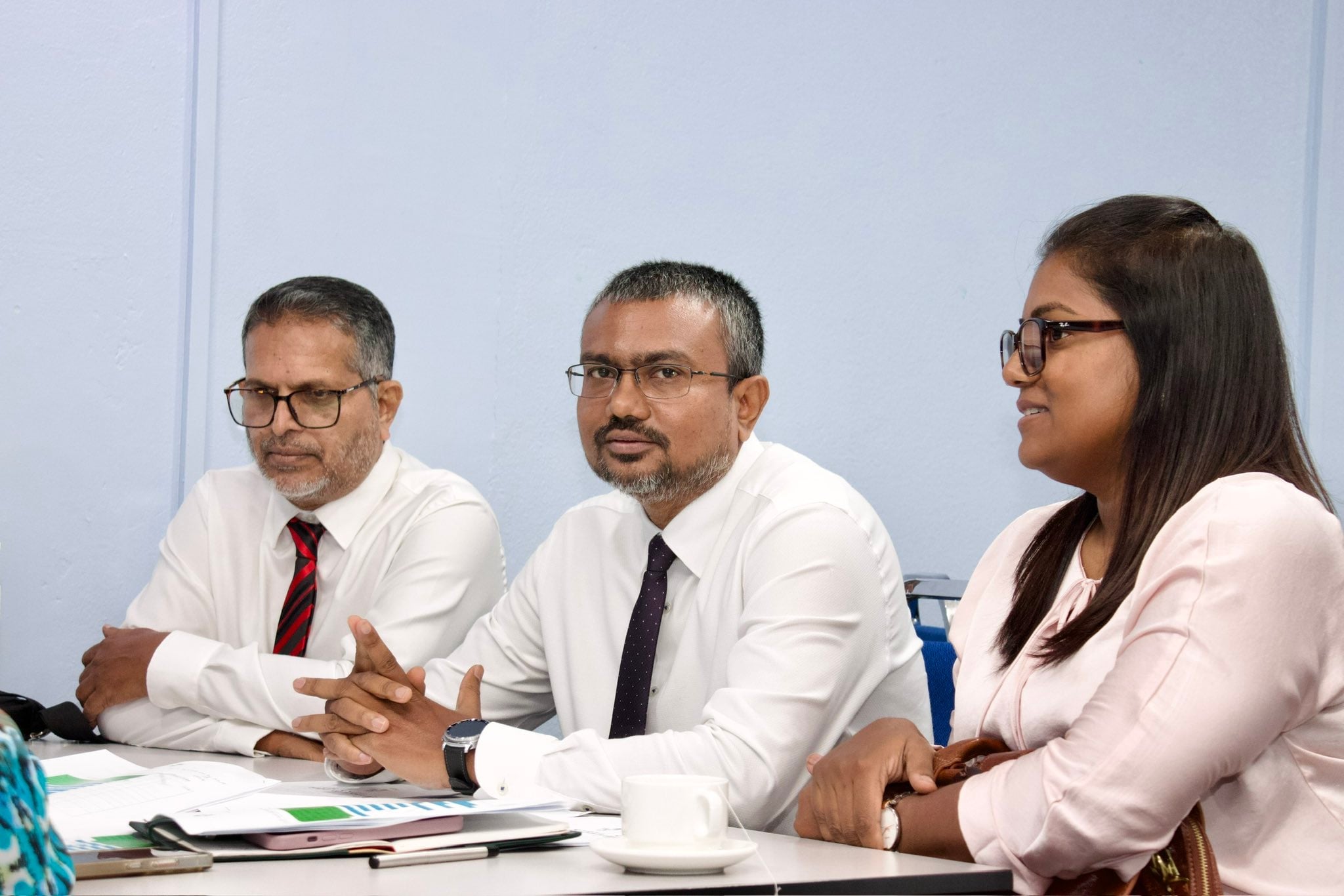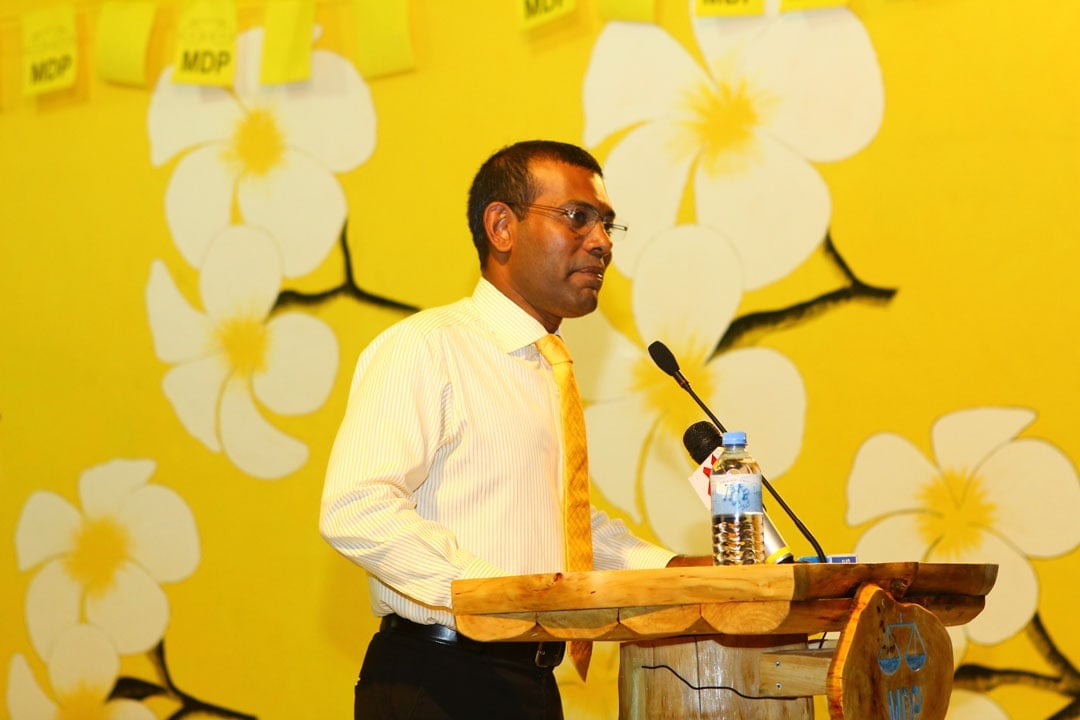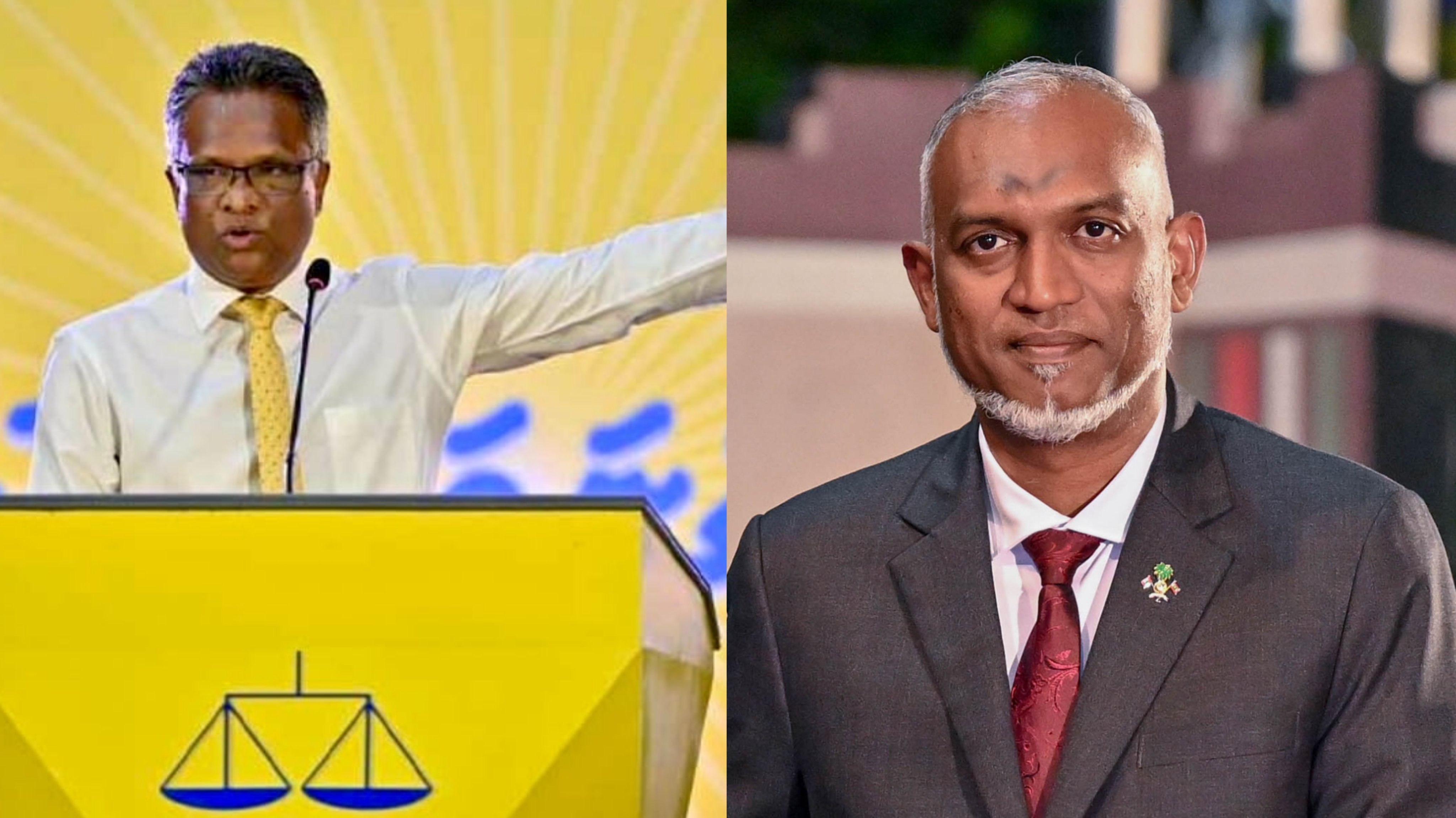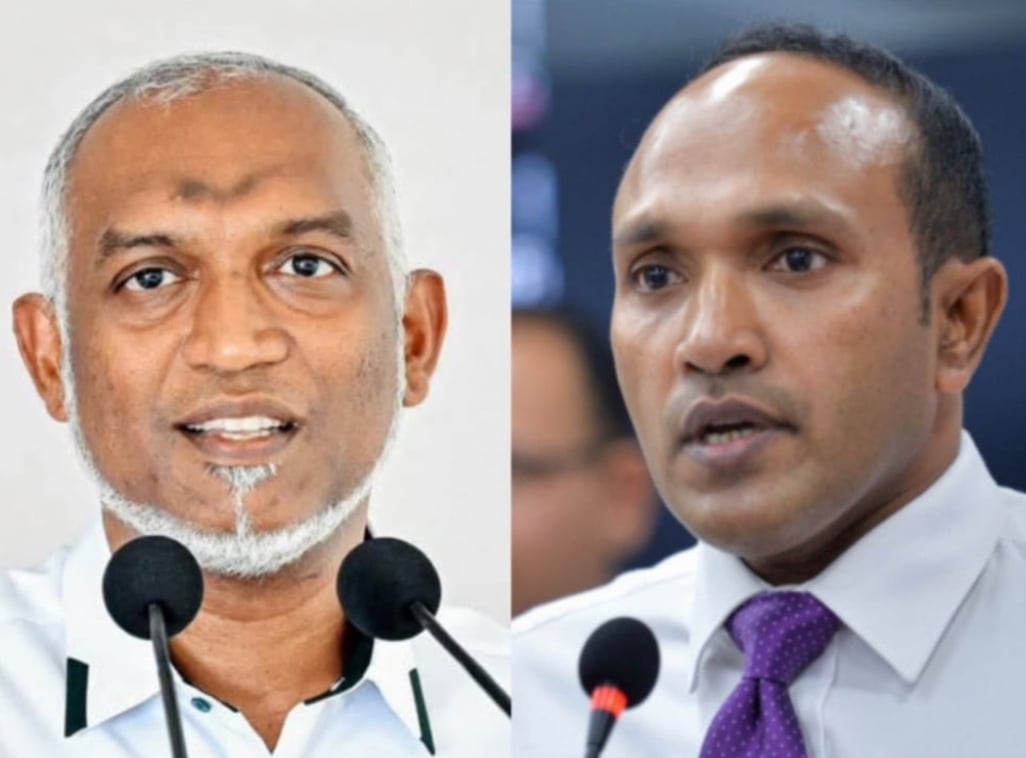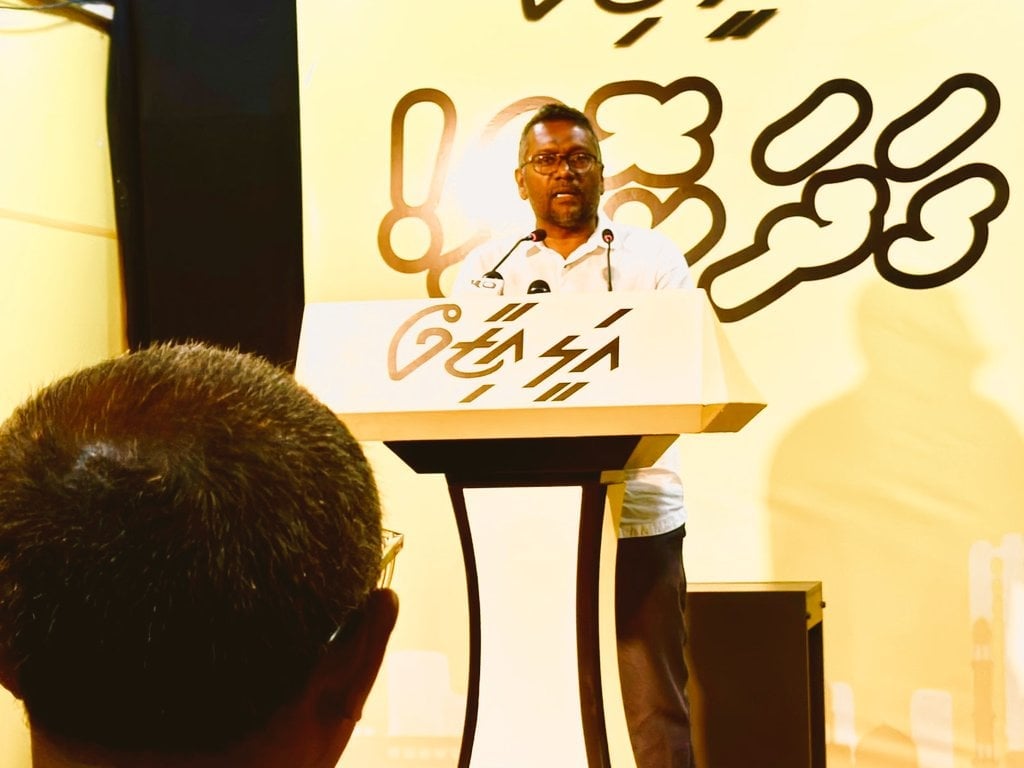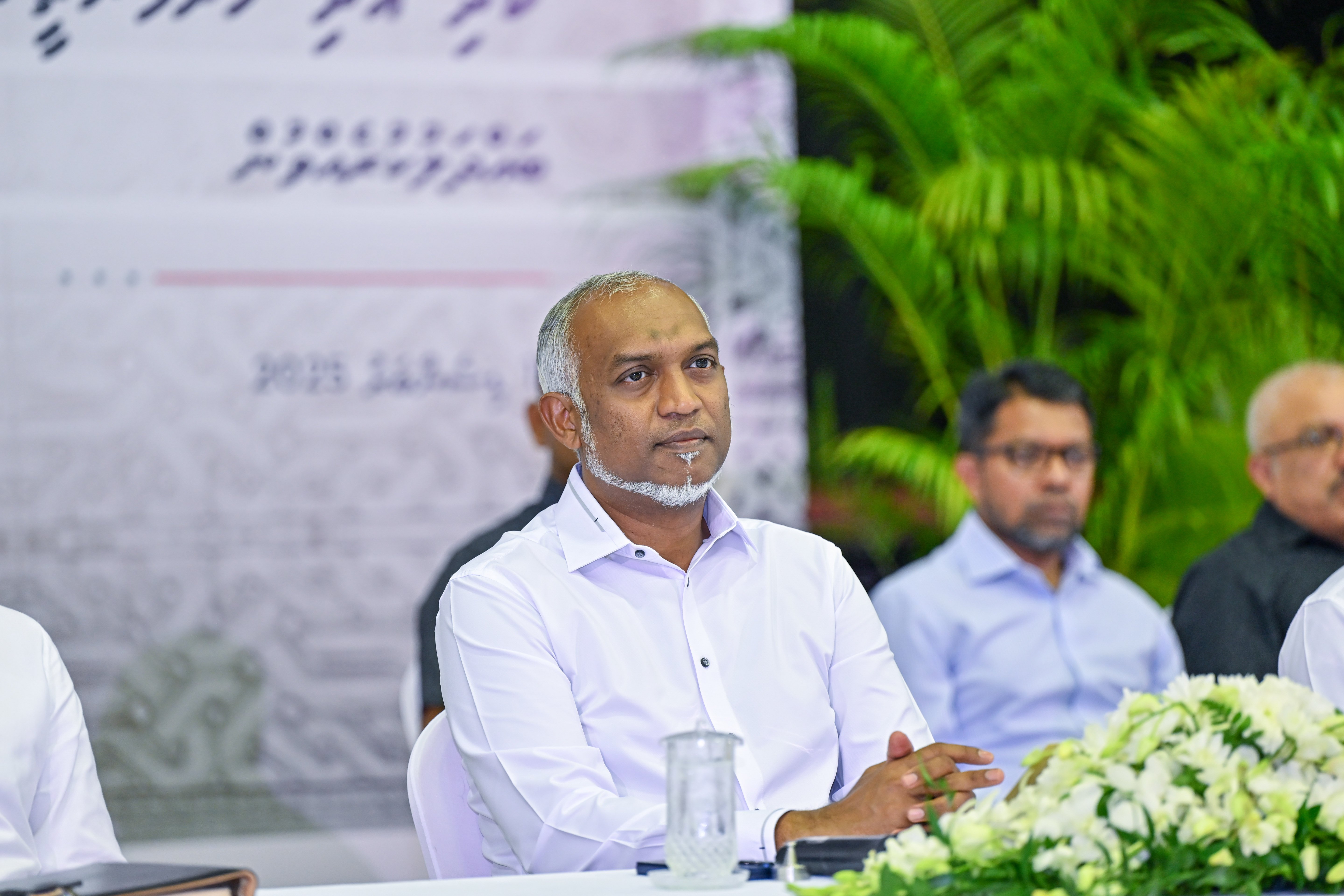According to the written history of the Maldives, the Maldives had an ancient monarchy, similar to other countries in the region. The monarchy was closely intertwined with Maldivian culture and traditions and proved to be very appropriate for the time and topography.
The transition from the old, established monarchy to a republican form of government in 1953 was not due to public dissatisfaction or social unrest. It was the result of gradual changes brought about under the vision and planning of the political elite of the time. In the course of these changes, the powers and principles of the monarchy were gradually eroded, paving the way for the obsolescence of the system.
H.C.P. Bell, who studied Maldivian history, states in his book 'The Maldives: 1920': "For many centuries past, and probably from the earliest days, the form of government which has ruled at the Maldives has been to a considerable degree that of a constitutional monarchy." The constitutional monarchy Bell refers to was not based on a written constitution as we see today, but was a system based on ancient customs and traditions.
The first written constitution in the Maldives was drafted and implemented 92 years ago, on 22 December 1932. At that time, the 10th king of the Huraa dynasty, Sultan Mohamed Shamsuddin III, was on the throne. It could be said that the 1932 constitution marked the beginning of the end of the long-standing monarchy in the Maldives. This constitution was not the result of the people rising up and demanding their rights. The rights and other matters outlined in that constitution were very alien to Maldivian society at that time. The constitution was formulated as a result of unrest between the then reigning Sultan Mohamed Shamsuddin and the political leaders of the time.
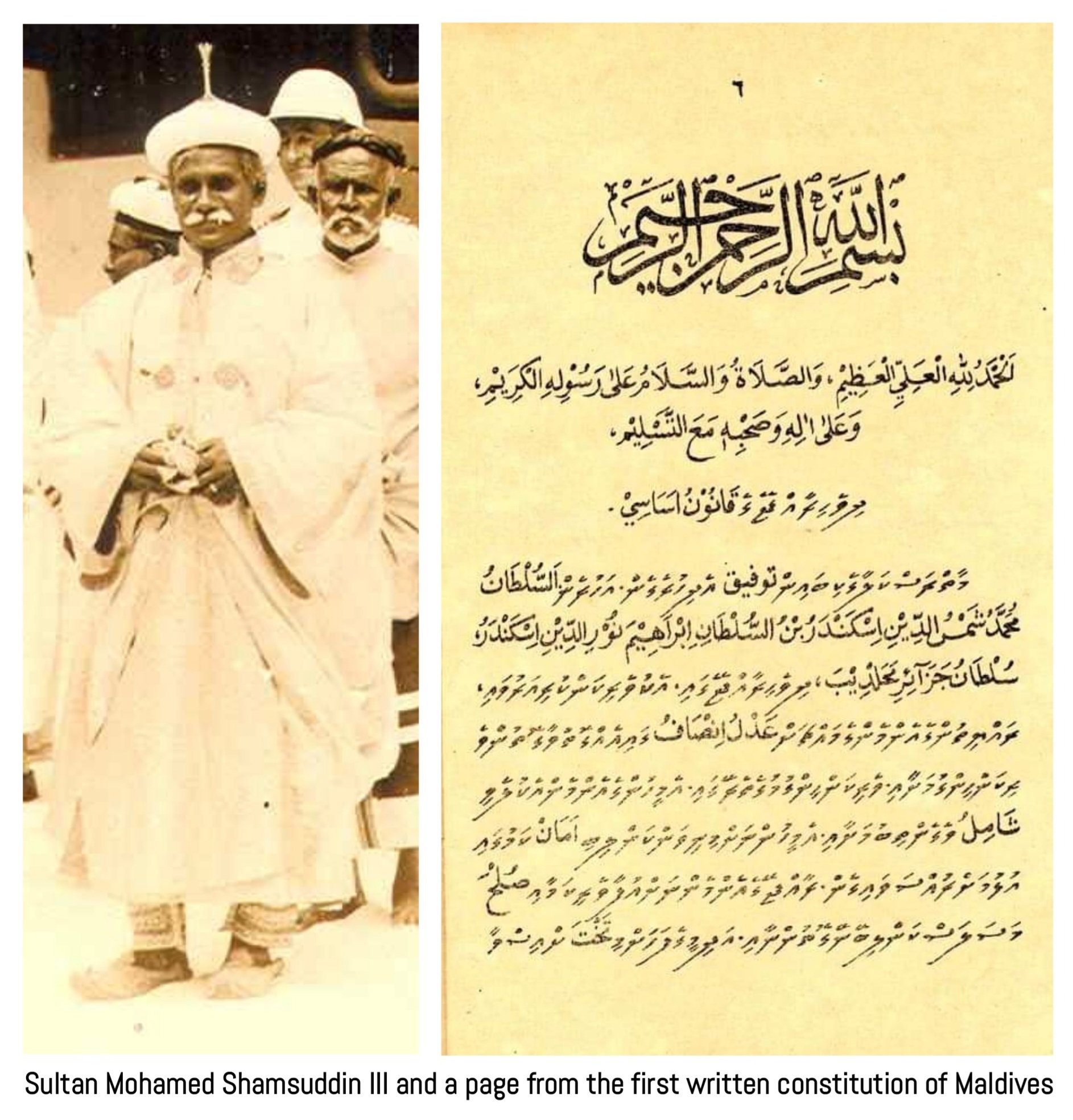
The first constitution, implemented in 1932, was 'torn up' and ended soon after, also due to conflicts between the king and the political leaders. A new constitution was drafted in 1934. However, tensions between the king and the politically powerful Athireege Bodun (chiefs) in the governance of the country continued to grow. This eventually led to the deposition of Sultan Mohamed Shamsuddin, the last king to rule the Maldives in the old way, and the exile of the king and his son, Crown Prince Hassan Izzuddin, to Fuvahmulah.
Shortly after Sultan Mohamed Shamsuddin was deposed, in 1935, the son of Sultan Mohamed Mueenuddin II, Prince Maajehigan'duvaru Manippulhu, was appointed to the throne as Sultan Hassan Nooraddin II. However, this king was very weak in power and prestige. During this king's reign, the constitution written and ratified in 1937 removed the requirement of being a descendant of Sultan Ghazi Hassan Izuddin, aka Dhon Bandaarain (the patriarch of the Huraa dynasty)lineage through in the male line, which had previously been a condition for becoming king. At this time, the Athireege family ruled the country with full political power. The supreme political leader was Abdul Majeed Didi (Rannaban'deyri Kilegefaanu). He was the Chief Advisor to the nation. After him came his two sons, Mohamed Fareed Didi and Hassan Fareed Didi. Then came Mohamed Amin Didi, the son of Abdul Majeed Didi's elder brother Ahmed Didi (Dorhimeynaa Kilegefaanu).

Under the 1937 Constitution, Sultan Hassan Nooraddin held the symbolic position of head of state, while Prime Minister Mohamed Fareed Didi served as the chief executive of the government. A new constitution was introduced in 1942. Under this new constitution, the roles of King and Prime Minister were changed to two symbolic positions of equal rank, and the Minister of Home Affairs became the head of government. Hassan Fareed Didi was the Minister of Home Affairs at the time.
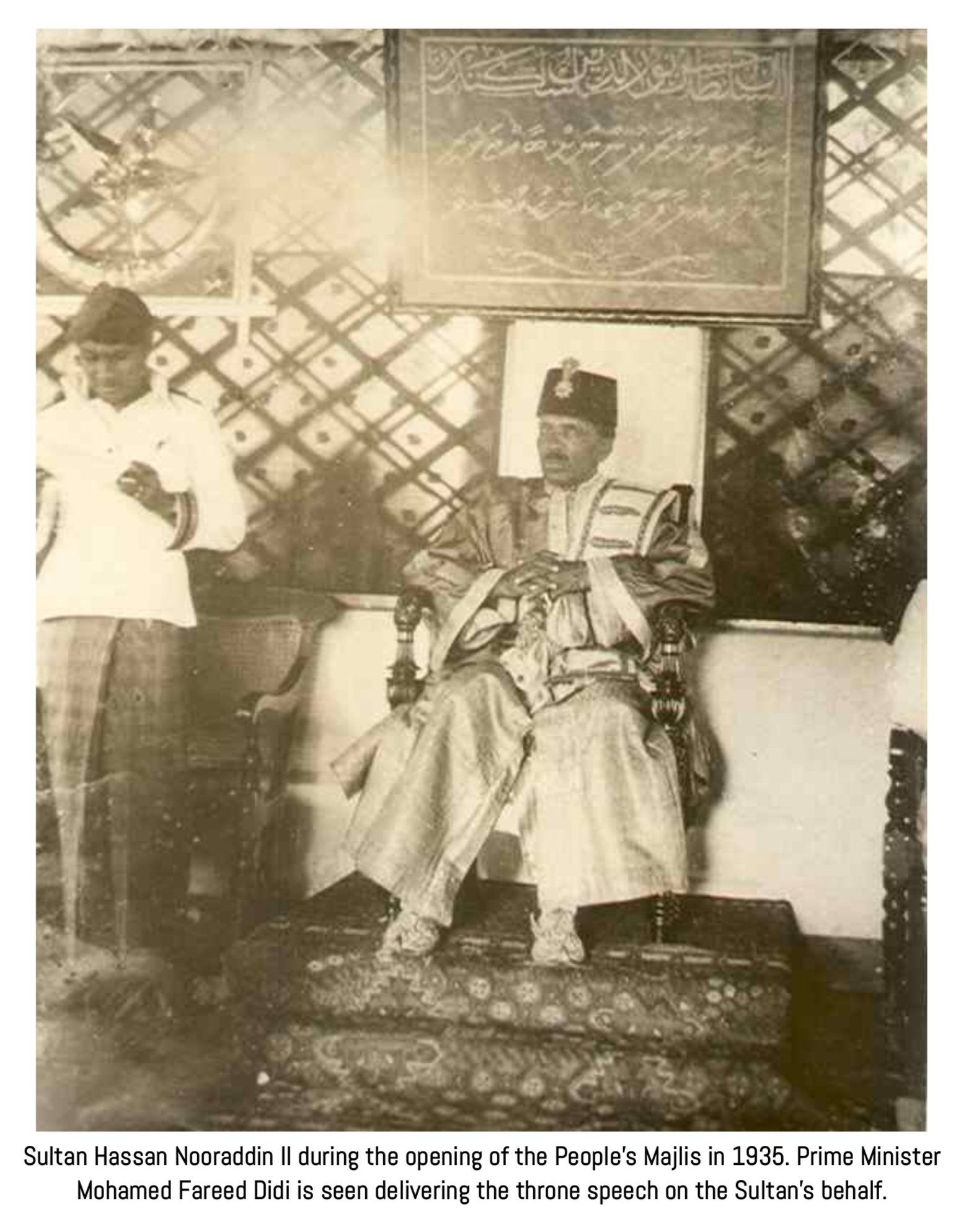
Then, on 8 April 1943, both the King and the Prime Minister resigned simultaneously and a Regency Committee took charge of all royal affairs. Subsequently, on 12 April 1943, the People's Majlis elected Abdul Majeed Rannaban'deyri Kilegefaanu as King of the Maldives, completely overturning the traditional monarchy system and electing a political leader unrelated to the previous royal dynasty. However, he did not ascend the throne or rule as king. He remained the 'King-Elect of the Maldives until his death in 1952.
When Abdul Majeed Rannaban'deyri Kilegefaanu was elected king but did not take office, a committee carried out some of the royal duties. A new constitution was also introduced in 1951, which ended the role of the Minister of Home Affairs as head of government and reinstated the Prime Minister as the chief executive. At that time, both the Minister of Home Affairs and the Prime Minister was Mohamed Amin Didi. After the death of Hassan Fareed in 1944, Mohamed Amin Didi became the most powerful and influential political leader in the government.
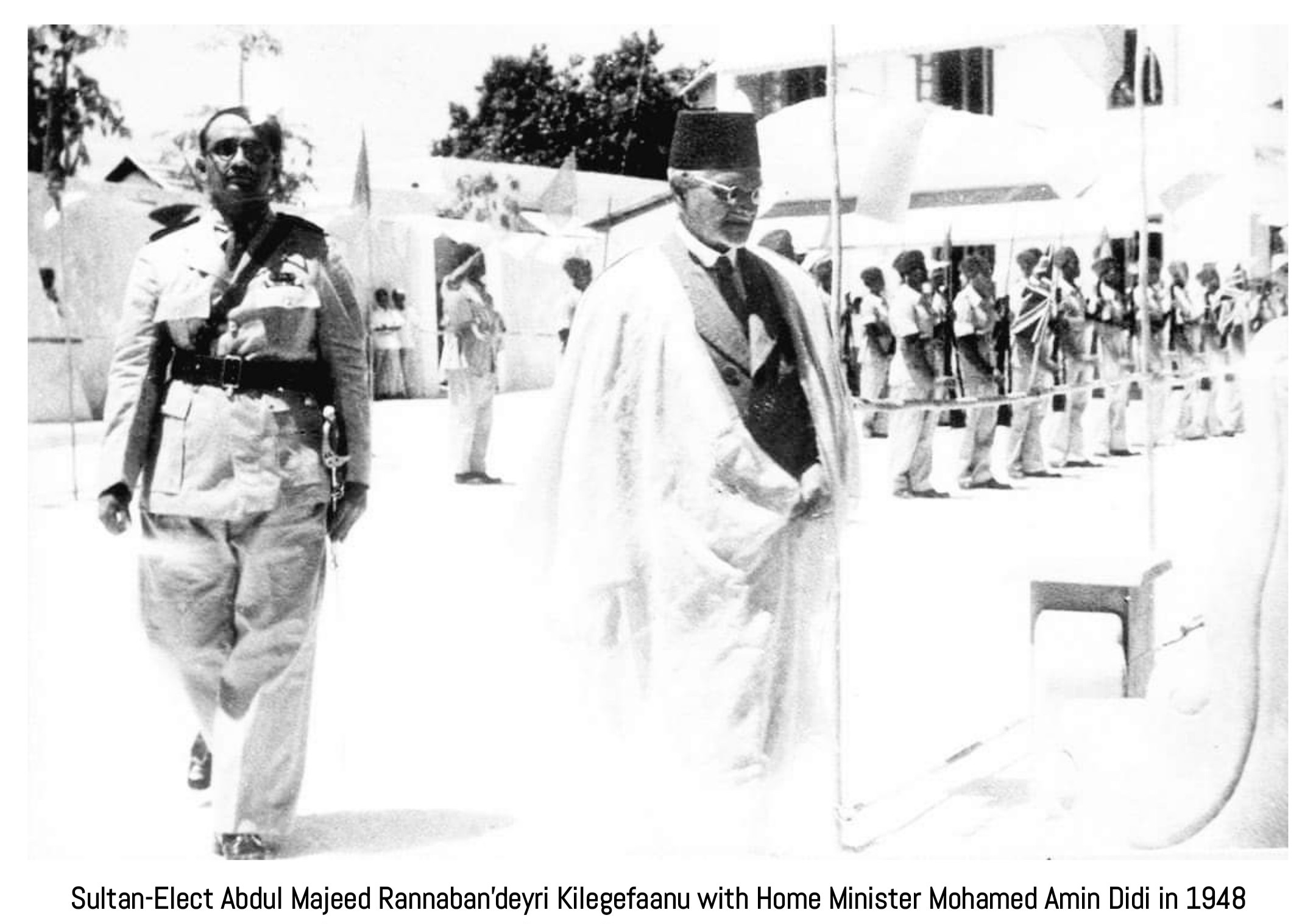
Later, on 20 October 1951, at a special session of the People's Majlis, it was proposed that Mohamed Amin Didi serve as both acting monarch and Guardian of the State (Waliyyul Amr) until Abdul Majeed Rannaban'deyri Kilegefaanu ascended to the throne. He declined to serve as acting monarch, but agreed to serve as Guardian of the State. The Majlis unanimously voted to appoint Mohamed Amin Dorhimeynaa Kilegefaanu as the Guardian of the State of the Maldives. He then took the oath and assumed office.
With the death of Abdul Majeed Rannaban'deyri Kilegefaanu in 1952, Mohamed Amin Didi became the most influential and powerful leader in all respects. The Bodun at that time could not imagine anyone other than Mohamed Amin Didi as the king or ruler of the Maldives. This could be considered as the real beginning of the end of the old monarchy of the Maldives.
On 12 April 1952, the People's Majlis discussed the "Principles of Governing the Maldives" and formed a special committee to decide the matter. After meetings at Athireege, the private residence of Mohamed Amin Didi, it was decided that "it has become necessary to transform the Maldives into a republic". To implement this change, it was decided to hold a public vote among the people of Male' and those from the atolls who were present in Male' at the time, and to proceed on the basis of the results.
Subsequently, on 14 and 15 April 1952, the people of Male' and those from the atolls who were in Male' at the time were given information about the vote to change the system of government. In this information session, Mohamed Amin Didi concluded his speech by stating that "due to various circumstances and at the request of the people, changing the country into a republic is important and necessary". Other prominent speakers, including Ibrahim Faamudheyri Kilegefaanu, Chief Justice Sheikh Abdullah Jalaluddin, Ibrahim Mohamed Didi and Ibrahim Shihab, also spoke in favour of a republic.
As mentioned above, the Maldivian people have been obedient and compliant to their leaders. In general, the public has supported the system of government that the leadership has deemed most appropriate. Thus, on 16 April 1952, a public vote was held among the people of Male' and the atolls present in Male', who almost unanimously decided to abolish the old monarchy of the Maldives and establish a republican government. Under this new system, Mohamed Amin Didi was elected President and Ibrahim Mohamed Didi was elected Vice-President. The country became a republic, as desired by the influential leaders in charge of the nation at the time. The people were left in a state of uncertainty.
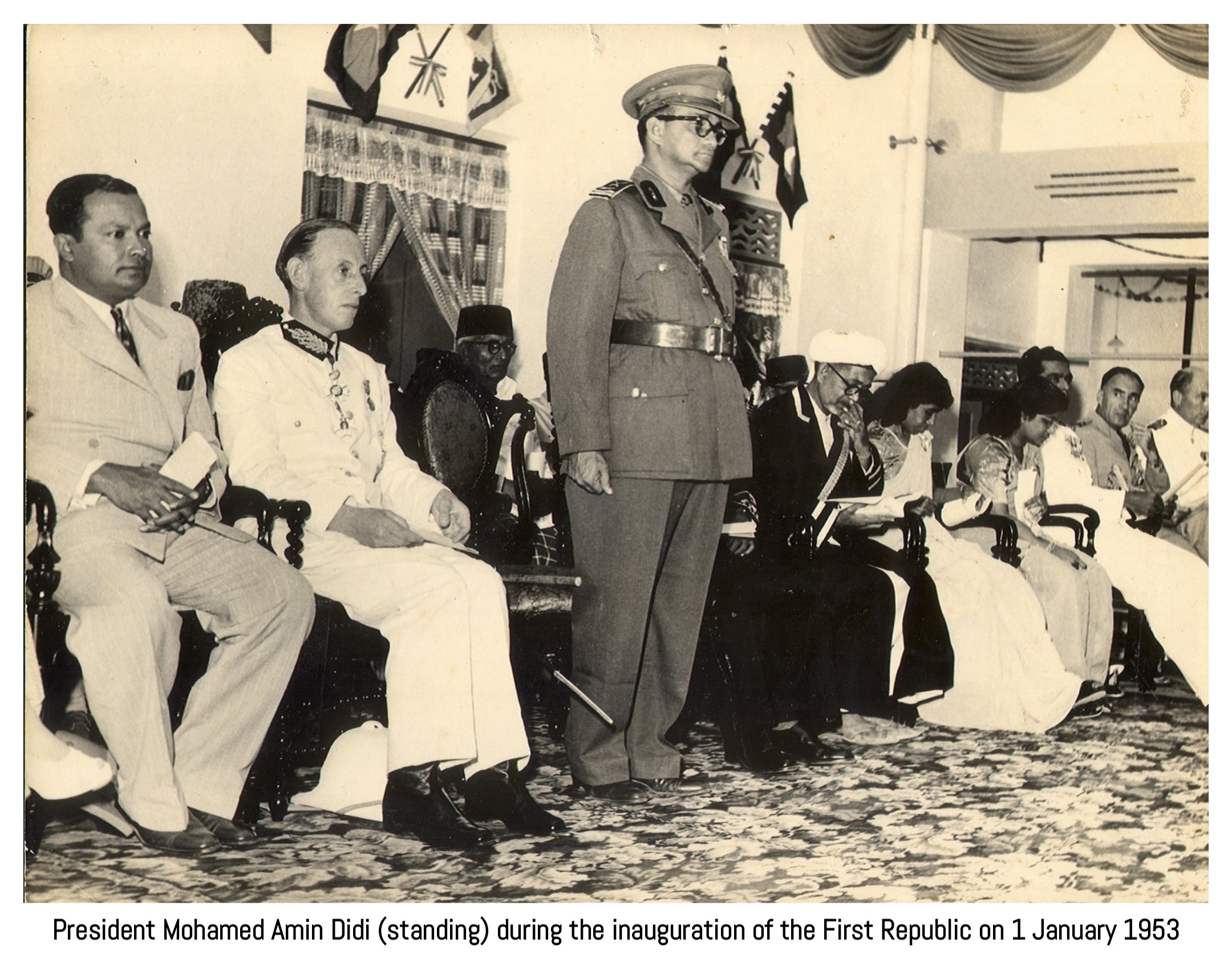
The decision to turn the Maldives into a republic did not seek the opinion of the citizens of the other islands, except those who were in Malé at the time. At that time, the majority of the country's population did not live in Male' as they do now. But no one complained. The Maldivian people lacked the conscience to complain about such a system of governance. Thus, the first republican government of the Maldives was established on this principle.
However, the duration of the republican system was shorter than the time it took to establish it. After the vote on 16 April 1952, the Republic was established on 1 January 1953, 8 months and 14 days later, and ended on 21 August 1953, after 7 months and 20 days. This event will go down in history as a "revolution", according to those involved. I have already told the story of this revolution to the readers of this newspaper. So I will not dwell on it.
After the end of Mohamed Amin Didi's republican rule, from 21 August 1953 to 6 March 1954, the Maldives was governed by a revolutionary committee led by Ibrahim Faamudheyri Kilegefaanu and Ibrahim Mohamed Didi. During this period, a new constitution based on monarchical principles was drafted to replace the republican constitution and passed by the People's Majlis on 31 January 1954.
A public vote was then held in Male on 5 February 1954 to determine the system of government for the Maldives. In accordance with the results of this vote, the monarchy was restored. By the time the monarchy was reestablished, the Maldives had been without a king for over 10 years. As a result, the monarchical system was severely weakened. The youth who had grown up during those 10 years had not experienced the grandeur and majesty of the monarchy. The existence of royal splendour and magnificence had become a system of government known only to the elderly.
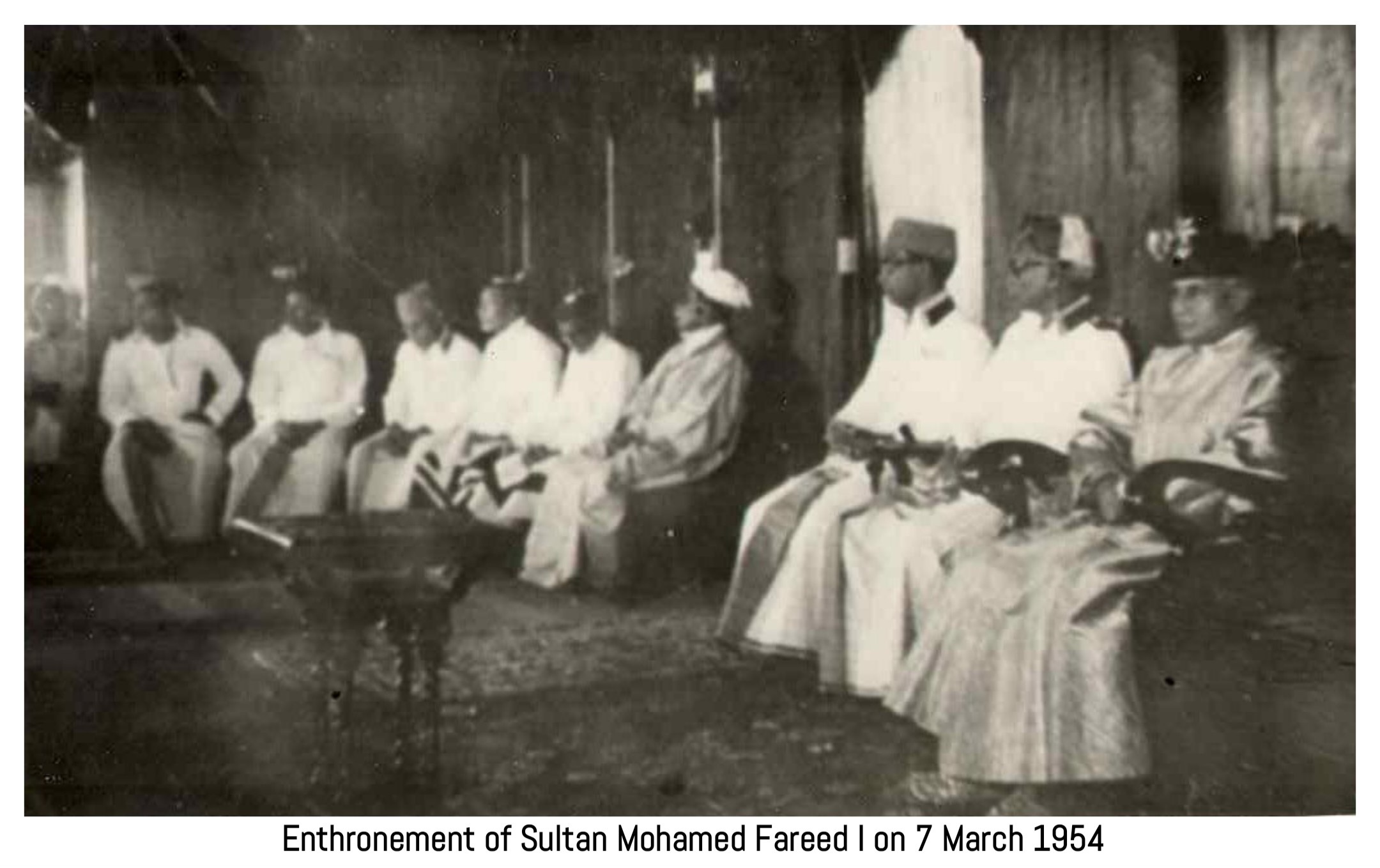
Nevertheless, on 21 February 1954, a special People's Majlis elected Mohamed Fareed Didi to the throne of the Maldives. He was the eldest son of Abdul Majeed Rannaban'deyri Kilegefaanu, who had previously been elected to the throne but died before his coronation. Although Mohamed Fareed was not directly related to the royal dynasty through the male line, his mother was a princess, a daughter of Sultan Ibrahim Nooraddin.
On 7 March 1954, after ascending the throne in the name of Sultan Mohamed Fareed I, he ratified the new constitution. And on 11 March 1954, on the advice of the newly elected People's Majlis, he appointed Ibrahim Faamudheyri Kilegefaanu as Prime Minister.
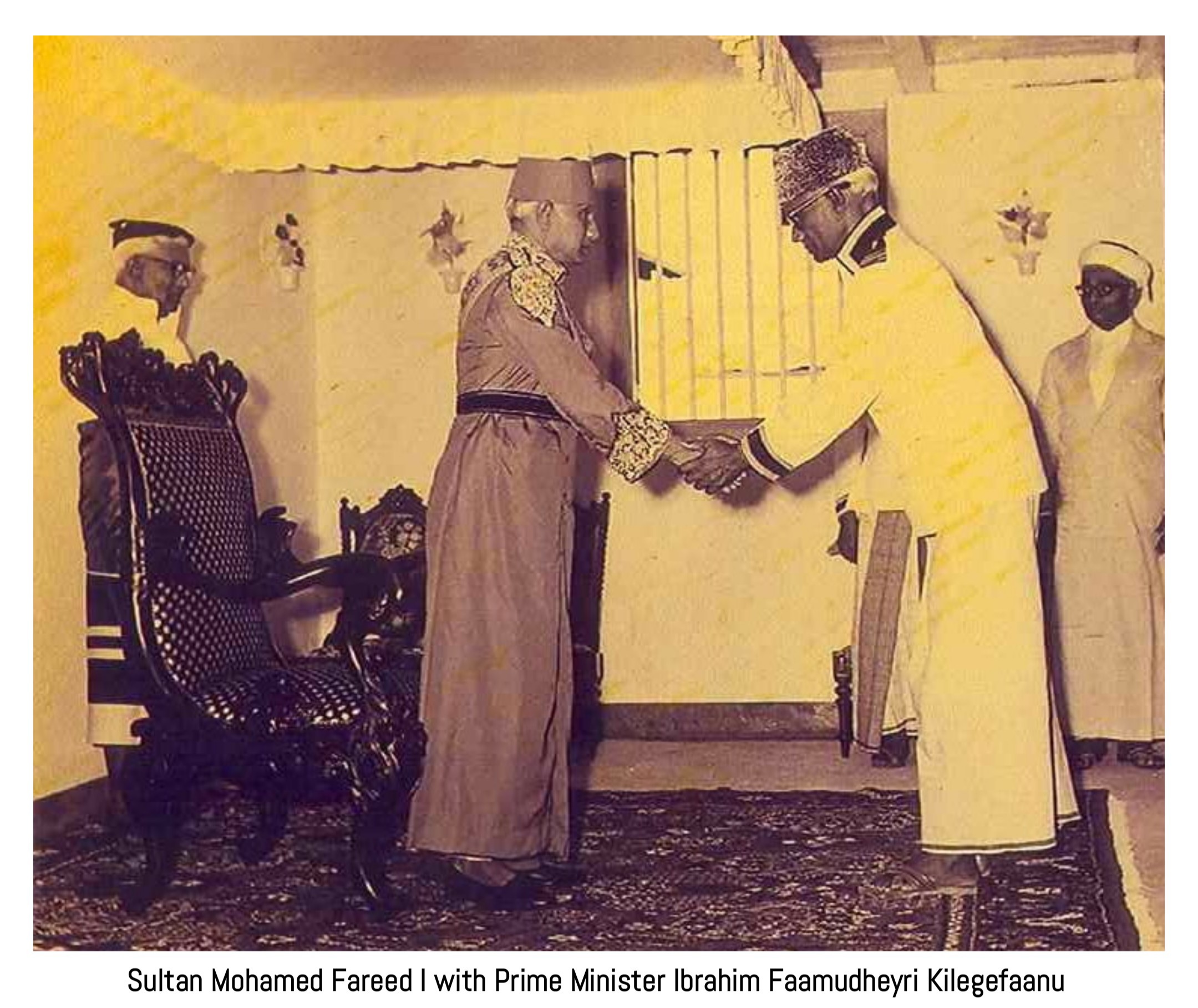
During Ibrahim Faamudheyri Kilegefaanu's premiership, he was forced to resign from the post of Prime Minister on 11 December 1957 as a result of political unrest over the issue of leasing Gan in Addu Atoll to the British. The following day, Sultan Mohamed Fareed I appointed Ibrahim Nasir as Prime Minister. Nasir had previously held the positions of Chief of Defence Force and Minister of Home Affairs. Ibrahim Nasir was the leader of the 'opposition party' (although there were no official political parties at the time) which opposed Ibrahim Faamudheyri Kilegefaanu on the issue of leasing Gan to the British. The day Ibrahim Nasir became Prime Minister is considered the beginning of the end of the old monarchy system for the second time. And after becoming Prime Minister, Ibrahim Nasir became the most politically powerful and influential person in the Maldives.
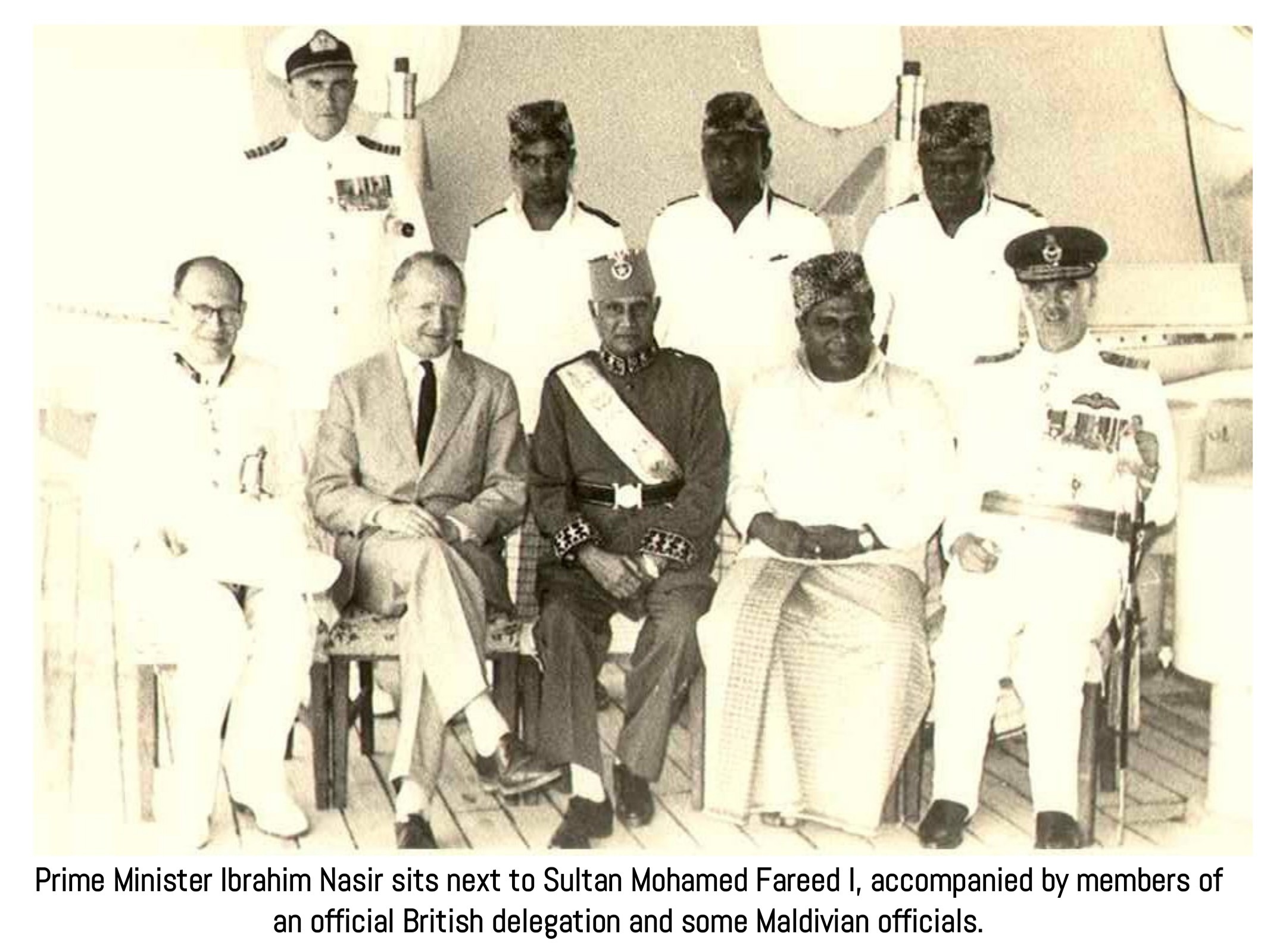
Ibrahim Shihab, who closely observed and lived through this period, wrote: "..A short time after Ibrahim Nasir's premiership, the relationship between the King and the Prime Minister began to deteriorate. The reason was the differences between what His Highness the King saw and what the Prime Minister saw. In this matter, what was seen from Sultan Mohamed Fareed was the importance he gave to reconciliation. In any case, even if those who didn't know didn't realize, as the king of the Maldives, the power he received was somewhat rightfully neglected by the state administration. The final result of this was the beginning of the movement to change the Maldivian monarchy into a republic for the second time."
From Ibrahim Shihab's account, we can very briefly understand the reason that led to the abolition of the monarchy and the establishment of a republican system for the second time. In fact, the transformation of the Maldives from a monarchy to a republic for the second time was, like the first time, because the ruler at the time wanted it. It was not a change brought about by the people, who opposed the system of government because they were dissatisfied with it.
On 15 November 1967, 13 years after the restoration of the monarchy following the short-lived republic of Mohamed Amin Didi, a vote was held in the People's Majlis to change the system of government in the Maldives. Of the 44 members present, 40 voted in favour of a change to a republican system.
Following this decision, a public referendum was held on 15 March 1968 to determine whether a monarchy or a republic was more suitable for the Maldives. The ballot paper used a star as the symbol for monarchy and a coconut palm as the symbol for republic. The coconut palm is a tree closely associated with all aspects of Maldivian life and is the most beneficial tree for Maldivians. We cannot say whether this was a tactic to mislead the people in order to gain votes, the traditionally obedient Maldivian people, 93.34% of them, voted for the republic, which was supported by the then head of state and the country's elite.
After the vote to change the system, a secret ballot was held in the People's Majlis on 9 September 1968 to select a candidate for the presidency. Ibrahim Nasir Rannaban'deyri Kilegefaanu, the prime minister at the time, was elected. A public referendum was then held on 27 September to seek the people's opinion on the appointment of Ibrahim Nasir as president.
With the people's support for his election as President, Ibrahim Nasir took the oath of office as the first President of the Second Republic of the Maldives on 11 November 1968. On the same day, he ratified the newly drafted Republican Constitution. At this point, the old monarchical system of the Maldives came to a complete end and the republican system of government was reintroduced.
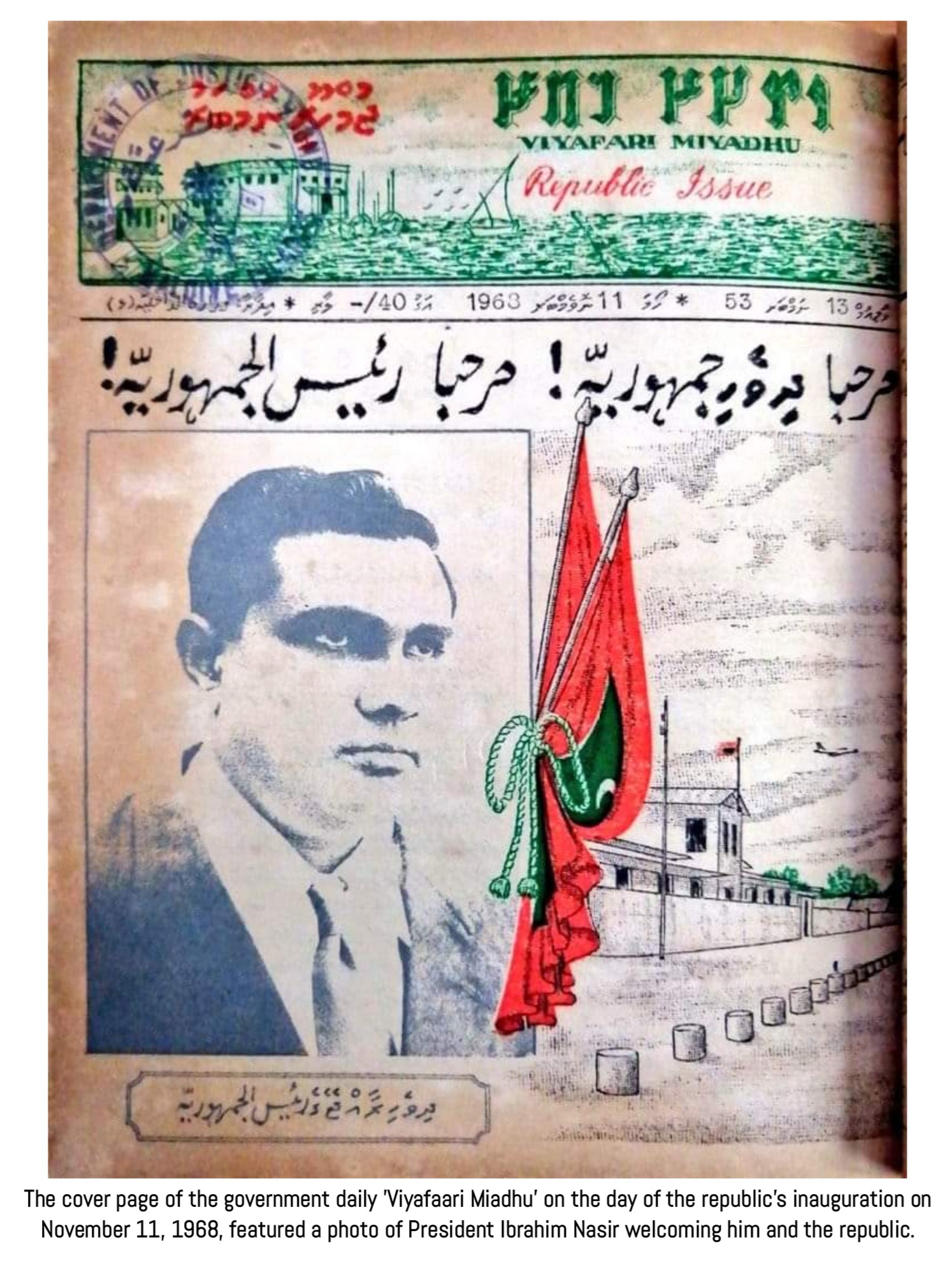
When the republican system of government was re-established in the Maldives on 11 November 1968, the system was very similar to a monarchy until the implementation of the 2008 Constitution. Even in the People's Majlis (Parliament), there were members of the President, similar as a king would have members. The president's orders were in the style of a king commanding his 'subjects', saying 'We decree and order'. In reality, a person elected by the people, from among the people, to govern on behalf of the people, should address the people by saying 'Alhugan'du' (I in the polite form). Recently, we have also seen attempts to make the President's status more 'royal' than it was before 2008. Thus, when referring to the President, we see people adding 'Fulhu' to the kinship terms, just as it was added to the royals. However, this was not the practice during the time of President Ibrahim Nasir or President Maumoon.
The real change that the Maldivian people brought about by coming out and raising their voices for rights and issues was the 2008 Constitution. Many rights that were not available to the people before were granted under this constitution. The republic has also been transformed into a truly participatory republic under the current constitution. The republican system introduced in the Maldives on 11 November 1968 was not at all a system brought about because the people wanted it or for the benefit of the people. It was a system brought in by the rulers for their benefit.
The transition from the old, established monarchy to a republican form of government in 1953 was not due to public dissatisfaction or social unrest. It was the result of gradual changes brought about under the vision and planning of the political elite of the time. In the course of these changes, the powers and principles of the monarchy were gradually eroded, paving the way for the obsolescence of the system.
H.C.P. Bell, who studied Maldivian history, states in his book 'The Maldives: 1920': "For many centuries past, and probably from the earliest days, the form of government which has ruled at the Maldives has been to a considerable degree that of a constitutional monarchy." The constitutional monarchy Bell refers to was not based on a written constitution as we see today, but was a system based on ancient customs and traditions.
The first written constitution in the Maldives was drafted and implemented 92 years ago, on 22 December 1932. At that time, the 10th king of the Huraa dynasty, Sultan Mohamed Shamsuddin III, was on the throne. It could be said that the 1932 constitution marked the beginning of the end of the long-standing monarchy in the Maldives. This constitution was not the result of the people rising up and demanding their rights. The rights and other matters outlined in that constitution were very alien to Maldivian society at that time. The constitution was formulated as a result of unrest between the then reigning Sultan Mohamed Shamsuddin and the political leaders of the time.

The first constitution, implemented in 1932, was 'torn up' and ended soon after, also due to conflicts between the king and the political leaders. A new constitution was drafted in 1934. However, tensions between the king and the politically powerful Athireege Bodun (chiefs) in the governance of the country continued to grow. This eventually led to the deposition of Sultan Mohamed Shamsuddin, the last king to rule the Maldives in the old way, and the exile of the king and his son, Crown Prince Hassan Izzuddin, to Fuvahmulah.
Shortly after Sultan Mohamed Shamsuddin was deposed, in 1935, the son of Sultan Mohamed Mueenuddin II, Prince Maajehigan'duvaru Manippulhu, was appointed to the throne as Sultan Hassan Nooraddin II. However, this king was very weak in power and prestige. During this king's reign, the constitution written and ratified in 1937 removed the requirement of being a descendant of Sultan Ghazi Hassan Izuddin, aka Dhon Bandaarain (the patriarch of the Huraa dynasty)lineage through in the male line, which had previously been a condition for becoming king. At this time, the Athireege family ruled the country with full political power. The supreme political leader was Abdul Majeed Didi (Rannaban'deyri Kilegefaanu). He was the Chief Advisor to the nation. After him came his two sons, Mohamed Fareed Didi and Hassan Fareed Didi. Then came Mohamed Amin Didi, the son of Abdul Majeed Didi's elder brother Ahmed Didi (Dorhimeynaa Kilegefaanu).

Under the 1937 Constitution, Sultan Hassan Nooraddin held the symbolic position of head of state, while Prime Minister Mohamed Fareed Didi served as the chief executive of the government. A new constitution was introduced in 1942. Under this new constitution, the roles of King and Prime Minister were changed to two symbolic positions of equal rank, and the Minister of Home Affairs became the head of government. Hassan Fareed Didi was the Minister of Home Affairs at the time.

Then, on 8 April 1943, both the King and the Prime Minister resigned simultaneously and a Regency Committee took charge of all royal affairs. Subsequently, on 12 April 1943, the People's Majlis elected Abdul Majeed Rannaban'deyri Kilegefaanu as King of the Maldives, completely overturning the traditional monarchy system and electing a political leader unrelated to the previous royal dynasty. However, he did not ascend the throne or rule as king. He remained the 'King-Elect of the Maldives until his death in 1952.
When Abdul Majeed Rannaban'deyri Kilegefaanu was elected king but did not take office, a committee carried out some of the royal duties. A new constitution was also introduced in 1951, which ended the role of the Minister of Home Affairs as head of government and reinstated the Prime Minister as the chief executive. At that time, both the Minister of Home Affairs and the Prime Minister was Mohamed Amin Didi. After the death of Hassan Fareed in 1944, Mohamed Amin Didi became the most powerful and influential political leader in the government.

Later, on 20 October 1951, at a special session of the People's Majlis, it was proposed that Mohamed Amin Didi serve as both acting monarch and Guardian of the State (Waliyyul Amr) until Abdul Majeed Rannaban'deyri Kilegefaanu ascended to the throne. He declined to serve as acting monarch, but agreed to serve as Guardian of the State. The Majlis unanimously voted to appoint Mohamed Amin Dorhimeynaa Kilegefaanu as the Guardian of the State of the Maldives. He then took the oath and assumed office.
With the death of Abdul Majeed Rannaban'deyri Kilegefaanu in 1952, Mohamed Amin Didi became the most influential and powerful leader in all respects. The Bodun at that time could not imagine anyone other than Mohamed Amin Didi as the king or ruler of the Maldives. This could be considered as the real beginning of the end of the old monarchy of the Maldives.
On 12 April 1952, the People's Majlis discussed the "Principles of Governing the Maldives" and formed a special committee to decide the matter. After meetings at Athireege, the private residence of Mohamed Amin Didi, it was decided that "it has become necessary to transform the Maldives into a republic". To implement this change, it was decided to hold a public vote among the people of Male' and those from the atolls who were present in Male' at the time, and to proceed on the basis of the results.
Subsequently, on 14 and 15 April 1952, the people of Male' and those from the atolls who were in Male' at the time were given information about the vote to change the system of government. In this information session, Mohamed Amin Didi concluded his speech by stating that "due to various circumstances and at the request of the people, changing the country into a republic is important and necessary". Other prominent speakers, including Ibrahim Faamudheyri Kilegefaanu, Chief Justice Sheikh Abdullah Jalaluddin, Ibrahim Mohamed Didi and Ibrahim Shihab, also spoke in favour of a republic.
As mentioned above, the Maldivian people have been obedient and compliant to their leaders. In general, the public has supported the system of government that the leadership has deemed most appropriate. Thus, on 16 April 1952, a public vote was held among the people of Male' and the atolls present in Male', who almost unanimously decided to abolish the old monarchy of the Maldives and establish a republican government. Under this new system, Mohamed Amin Didi was elected President and Ibrahim Mohamed Didi was elected Vice-President. The country became a republic, as desired by the influential leaders in charge of the nation at the time. The people were left in a state of uncertainty.

The decision to turn the Maldives into a republic did not seek the opinion of the citizens of the other islands, except those who were in Malé at the time. At that time, the majority of the country's population did not live in Male' as they do now. But no one complained. The Maldivian people lacked the conscience to complain about such a system of governance. Thus, the first republican government of the Maldives was established on this principle.
However, the duration of the republican system was shorter than the time it took to establish it. After the vote on 16 April 1952, the Republic was established on 1 January 1953, 8 months and 14 days later, and ended on 21 August 1953, after 7 months and 20 days. This event will go down in history as a "revolution", according to those involved. I have already told the story of this revolution to the readers of this newspaper. So I will not dwell on it.
After the end of Mohamed Amin Didi's republican rule, from 21 August 1953 to 6 March 1954, the Maldives was governed by a revolutionary committee led by Ibrahim Faamudheyri Kilegefaanu and Ibrahim Mohamed Didi. During this period, a new constitution based on monarchical principles was drafted to replace the republican constitution and passed by the People's Majlis on 31 January 1954.
A public vote was then held in Male on 5 February 1954 to determine the system of government for the Maldives. In accordance with the results of this vote, the monarchy was restored. By the time the monarchy was reestablished, the Maldives had been without a king for over 10 years. As a result, the monarchical system was severely weakened. The youth who had grown up during those 10 years had not experienced the grandeur and majesty of the monarchy. The existence of royal splendour and magnificence had become a system of government known only to the elderly.

Nevertheless, on 21 February 1954, a special People's Majlis elected Mohamed Fareed Didi to the throne of the Maldives. He was the eldest son of Abdul Majeed Rannaban'deyri Kilegefaanu, who had previously been elected to the throne but died before his coronation. Although Mohamed Fareed was not directly related to the royal dynasty through the male line, his mother was a princess, a daughter of Sultan Ibrahim Nooraddin.
On 7 March 1954, after ascending the throne in the name of Sultan Mohamed Fareed I, he ratified the new constitution. And on 11 March 1954, on the advice of the newly elected People's Majlis, he appointed Ibrahim Faamudheyri Kilegefaanu as Prime Minister.

During Ibrahim Faamudheyri Kilegefaanu's premiership, he was forced to resign from the post of Prime Minister on 11 December 1957 as a result of political unrest over the issue of leasing Gan in Addu Atoll to the British. The following day, Sultan Mohamed Fareed I appointed Ibrahim Nasir as Prime Minister. Nasir had previously held the positions of Chief of Defence Force and Minister of Home Affairs. Ibrahim Nasir was the leader of the 'opposition party' (although there were no official political parties at the time) which opposed Ibrahim Faamudheyri Kilegefaanu on the issue of leasing Gan to the British. The day Ibrahim Nasir became Prime Minister is considered the beginning of the end of the old monarchy system for the second time. And after becoming Prime Minister, Ibrahim Nasir became the most politically powerful and influential person in the Maldives.

Ibrahim Shihab, who closely observed and lived through this period, wrote: "..A short time after Ibrahim Nasir's premiership, the relationship between the King and the Prime Minister began to deteriorate. The reason was the differences between what His Highness the King saw and what the Prime Minister saw. In this matter, what was seen from Sultan Mohamed Fareed was the importance he gave to reconciliation. In any case, even if those who didn't know didn't realize, as the king of the Maldives, the power he received was somewhat rightfully neglected by the state administration. The final result of this was the beginning of the movement to change the Maldivian monarchy into a republic for the second time."
From Ibrahim Shihab's account, we can very briefly understand the reason that led to the abolition of the monarchy and the establishment of a republican system for the second time. In fact, the transformation of the Maldives from a monarchy to a republic for the second time was, like the first time, because the ruler at the time wanted it. It was not a change brought about by the people, who opposed the system of government because they were dissatisfied with it.
On 15 November 1967, 13 years after the restoration of the monarchy following the short-lived republic of Mohamed Amin Didi, a vote was held in the People's Majlis to change the system of government in the Maldives. Of the 44 members present, 40 voted in favour of a change to a republican system.
Following this decision, a public referendum was held on 15 March 1968 to determine whether a monarchy or a republic was more suitable for the Maldives. The ballot paper used a star as the symbol for monarchy and a coconut palm as the symbol for republic. The coconut palm is a tree closely associated with all aspects of Maldivian life and is the most beneficial tree for Maldivians. We cannot say whether this was a tactic to mislead the people in order to gain votes, the traditionally obedient Maldivian people, 93.34% of them, voted for the republic, which was supported by the then head of state and the country's elite.
After the vote to change the system, a secret ballot was held in the People's Majlis on 9 September 1968 to select a candidate for the presidency. Ibrahim Nasir Rannaban'deyri Kilegefaanu, the prime minister at the time, was elected. A public referendum was then held on 27 September to seek the people's opinion on the appointment of Ibrahim Nasir as president.
With the people's support for his election as President, Ibrahim Nasir took the oath of office as the first President of the Second Republic of the Maldives on 11 November 1968. On the same day, he ratified the newly drafted Republican Constitution. At this point, the old monarchical system of the Maldives came to a complete end and the republican system of government was reintroduced.

When the republican system of government was re-established in the Maldives on 11 November 1968, the system was very similar to a monarchy until the implementation of the 2008 Constitution. Even in the People's Majlis (Parliament), there were members of the President, similar as a king would have members. The president's orders were in the style of a king commanding his 'subjects', saying 'We decree and order'. In reality, a person elected by the people, from among the people, to govern on behalf of the people, should address the people by saying 'Alhugan'du' (I in the polite form). Recently, we have also seen attempts to make the President's status more 'royal' than it was before 2008. Thus, when referring to the President, we see people adding 'Fulhu' to the kinship terms, just as it was added to the royals. However, this was not the practice during the time of President Ibrahim Nasir or President Maumoon.
The real change that the Maldivian people brought about by coming out and raising their voices for rights and issues was the 2008 Constitution. Many rights that were not available to the people before were granted under this constitution. The republic has also been transformed into a truly participatory republic under the current constitution. The republican system introduced in the Maldives on 11 November 1968 was not at all a system brought about because the people wanted it or for the benefit of the people. It was a system brought in by the rulers for their benefit.





